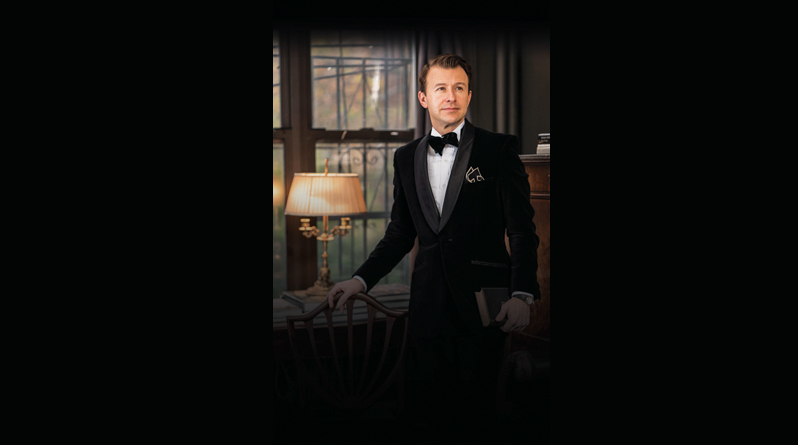

When bespoke tailor Raishabh Manocha was asked where he came from, he identifies himself to have come from Oman. While he spent his nascent childhood in various parts of India, Oman has become a home to him. While India introduced him to colour, texture and silhouette, the clean lines of the Omani desert taught him early on the balance between fastidious finesse and organic craftsmanship.

Today, Rishabh is proud to be a bespoke tailor who primarily makes Savile Row style suits for the discerning modern gentleman. His impeccable experience had him work hand-in-glove with Rory Duffy, a fifth-generation Savile Row tailor and Golden Shears winner.
Rishabh’s expertise extends to the more fashion-forward temperament of the clients of today. It combines the principles of the Row and reinterprets them to tastes more whimsical and idiosyncratic in nature.
“Most men often think of an old man in the back of a department store altering garments when one says ‘tailor’. But, tailoring suits is an arduous craft that portrays what the human hand can sculpt with a cloth and what the human eye can measure in finesse,” he said.
Oman Daily Observer reached out to Rishabh to learn more about what he does and what his tips are if a modern man wants to suit up.

What do you think most men don’t know when clothing themselves? What are some of the most common misconceptions about dressing and choosing clothes?
One doesn’t need a black suit! A black suit simply looks cheap and inexpensive no matter how hard one tries.
Substitute it with a midnight blue or charcoal grey.
Form and function go hand in hand. Men shouldn’t wear suits they are uncomfortable in. If the suit is a size too small, go to a tailor and get it fixed. Even better, have it bespoke and skip the hassle altogether. Comfort leads to greater ease that is in turn reflective in the form of the garment.
As a bespoke tailor, what needs do you meet that can’t be met by off-the-rack garments?
Off- the rack suits for the most part lack quality and craftsmanship. In the rare cases that they are well-made, they lack the particular fit a client might look one’s finest in. A generic pattern available in RTW can simply not deliver the precise pattern of a bespoke suit. Our bodies are not symmetrical and rigid to follow the numerics of machine-generated pattern. Rather, they are nuanced, and hence need to be met on a case by case basis for immaculate fit, comfort and durability in clothing.

Do your customers fit into a profile? Do they have anything in common? Can you tell me some of the people you’ve worked with?
I have had the good fortune of working with writers, auctioneers, fashion designers, hairstylists, actors and bankers. They all wish to reflect their inherent nature through their clothing. Be it theatrical, austere or simply practical, the bespoke process empowers them to control their visage in an uncompromising way.
How much would an entry-level bespoke suit in terms of cost and fittings? How does that compare to made-to-measure garments?
My suits start at $3500 for the semi-bespoke/MTM and $4500 for full bespoke variable on fabric. A typical made-to-measure garment uses an existent pattern, which is adjusted to client needs. My MTM programme is slightly more personal and comprehensive. One gets a fresh pattern to exact specifications. This way, a good fit is always ensured. Finer nuances of posture, style and make can only be accommodated in bespoke, but semi-bespoke is just as promising for a garment fairly straight-jacketed. No pun intended.
Is it better value for money to have clothes made? If so, how?
Indeed, it is. It is better for you, for the planet and for the trade. It is an investment in as far as durability and function go. Hand-cut and crafted garments will always stand the test of time no matter what the trend or how much one uses or abuses them. It is sustainable in its very nature of production. Very little raw material is wasted. Every little scrap is put to optimal use. As a result, fewer garments are made thereby reducing the carbon footprint on the planet.
What possibilities open up if a gentleman chooses bespoke?
The sky’s the limit! From a classic James Bond-style dinner jacket, velvet sailor pants, Arabesque dressing robes to couture frock coats, I have done them all. One’s imagination is really the only barrier.
Tailoring is largely regarded as a classic, European inspired menswear. But with many sartorial men choosing streetwear, how does modern fashion play a part in your craft, and do customers want it?
Yes, historically tailored garments have been classic and European- inspired. The resurgence of streetwear today implores both tailors and consumers to think
outside the box. Very often, tailors do not entertain certain styles because they are outside the purview of what’s considered ‘classic’ or ‘tailor-made’. I find that preposterous. As I said, from sailor pants to robes to bespoke sports jackets, there has been a keen interest in off-beat garments. Tradition always becomes security, and a secure mind is a decaying one. Hence, I always like to push my clients to try new ideas, just ever to slightly, tipping the hat just a degree.
What ten things does every man need in his wardrobe? And can you make those?
1. A white button-down shirt.
2. Navy blue two-piece suit.
3. Cashmere/wool overcoat
4. Necktie
5. Linen trousers
6. Cardigan/Sweater
7. Cashmere/wool scarf
8. Dinner suit (tuxedo)
9. Sport coat/ Blazer
10. White t-shirt
I can make them all with the exception of the knits.
Oman Observer is now on the WhatsApp channel. Click here



